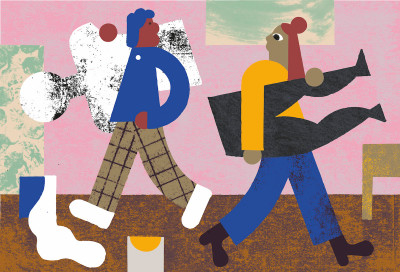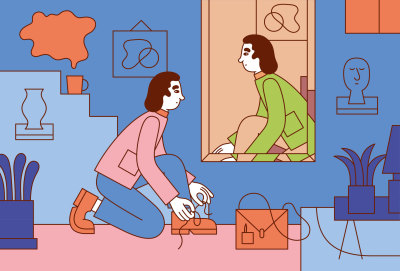Are high prices good for art?
Are high prices good for art?
The Question
By Georgina Adam and J.J. Charlesworth
Published 29 August 2014
Georgina Adam says that the money has allowed artists and art lovers new opportunities, while J.J. Charlesworth argues that high prices have turned artworks into investments.
-
Yes…
Every six months, it seems, the prices for art take a huge lurch upwards. Christie’s or Sotheby’s hold another sale that pulverises the results of the last one: a swathe of new price highs are set and a few brand-name artists once again hit the headlines. So a Jeff Koons Balloon Dog can make an eye-watering £34.75m or a ‘Joke’ painting by Richard Prince can make over a million dollars.
More occasionally, news of an astonishing private sale filers out: £44.5m last year for Leonardo’s Salvator Mundi; a cool £147.7m for Cézanne’s The Card Players in 2011. Such stratospheric prices are in fact only achieved at the top of the market, for very few artists, and on the secondary, or resale, market. Even rarer are artists who can even dream of such sums on the primary (first sale) market.
Nevertheless, I would argue that the current boom is, overall, good for art and for the art world. The sheer amount of money that is flowing into the market today – an estimated £47.42 billion in 2013 – has given artists, and art, far more opportunities, a far higher profile, and a far more positive status in society than ever. Remember when a career as an artist was a ‘no-no’, generally a direct route to penury and obscurity? No longer so. In our highly visual, image-driven society, the creativity and the imagination of the artist is in demand in multiple domains, from advertising, fashion and pop music to luxury goods. Art is hip, art is hot: far more people today know the names of contemporary artists, and art is embedded much more deeply in the national consciousness – just look at Tate’s record 7.7 million visitors in 2012-13.
While today’s mega-prices go to a tiny handful of artists who are working – along with their collectors – in a seemingly parallel universe, there is much available at far lower prices. The Royal Academy sells art at a wide range of prices at the Summer Exhibition. Websites dedicated to art sales offer original works of art from a few hundred pounds, and events such as print fairs or the Affordable Art fairs are also good for ‘starter’ collectors.
-
High prices have enabled many artists to follow their dreams and go places they couldn’t have dreamed of.
Georgina Adam
-
Today’s art boom has also given artists unprecedented international exposure. The number of biennials has grown to over 100 events each year reaching across the globe. Between September and Christmas this year, for example, there are no less than 15 of these ostensibly non-profit events, including those in São Paulo, Fukuoka in Japan and Kochi-Muziris in India. Without the amount of money now swirling around the art world these events simply would not be happening.
The number of art fairs has mushroomed even more, with at least 220 major ones worldwide. And clustered around the main fairs are the far more affordable satellites – often the places to make real discoveries. Fairs also have a positive fall-out on their host city: Frieze, for example, has transformed the once fallow month of October in London, offering gallery openings and new exhibitions, in addition to the fair itself.
It’s not just artists and the general public who are benefitting – there are far more jobs available in the art world than ever before. London’s specialist recruitment agency Sophie Macpherson can hardly keep up with demand. Curators, art advisors, gallery staff, auction house specialists, artists’ managers… all have the high prices of art to thank for being able to do what they love.
Now, is the art ‘good’ as a result of all this? This is another matter entirely, which future generations will have to judge. What I can say is that today’s high prices have enabled many artists to follow their dreams and go places that they couldn’t have dreamed of. In what other period could Antony Gormley RA be given the chance to design a luxury hotel suite, which takes the form of a sculpture, for a swanky new £40m Mayfair establishment, and at the same time offer the free spectacle of the Angel of the North – seen by 150,000 visitors a year, plus another 90,000 drivers every day passing by on the A1?
-
No…
Let’s be fair. It’s probably the case that high prices for art are very good for artists (and their dealers), and it’s always nice to see artists who are happy because they can now afford to buy themselves a new Porsche, or that second house in the south of France, or be able to cover the salaries of a few more studio assistants.
But joking aside, what is good for artists is not necessarily good for art. So where does the difference lie? If you’re a critic like I am, you probably get into writing about art because you find art exciting, interesting and inspiring. More importantly, you get into writing about it because you think what art does is important enough to tell other people about it and to argue about why art matters in our culture.
You don’t need to own art to have an opinion about it, so its price is an irrelevance, since the cultural value of an artwork for a whole community is more important than the price a particular individual may want to pay for it. Just as a Hollywood blockbuster isn’t worthwhile because of the money spent on it but because of what we the public think of it, so contemporary art’s value to our culture isn’t reducible to what a tiny minority of wealthy people want to pay for it.
The trouble today, however, is that the cultural value of art is too often thought of as synonymous with the price paid for artworks by this tiny minority. The gossipy, puerile chatter of commentators who are more fascinated by the self-indulgence of the ultra-rich than the significance of the art the ultra-rich happen to buy has replaced any substantial debate about what might be good and bad in art. In this, it is the tastes and predilections of very rich collectors that have come to count, above all else.
This would be alright if those collectors had good taste – great art of the past was often made possible by enlightened patronage. But collectors of contemporary art mostly don’t have good taste; or at least, if the kind of art that regularly fetches millions is anything to go by, the taste of some collectors seems to be no more advanced than that of an average child.
What we see today is that a kind of art is being made which slavishly reflects the taste of those who buy it, regardless of whatever anyone else thinks. And whatever an artist might think to the contrary, an artist who makes art uniquely to flatter his collector’s taste, in anticipation of the cash that will follow, soon becomes a slave to it.
-
An artist who makes art uniquely to flatter his collector’s taste, in anticipation of the cash that will follow, soon becomes a slave to it.
J.J. Charlesworth
-
High prices are, however, bad for art in another way. If, culturally, the high prices paid for contemporary art have turned it into a ritual of status display for the new global rich, the high prices paid for art also represent the financialisation of art.
Financialisation means turning the buying and selling of art into nothing more than another asset class, just another investment opportunity. So when a rich collector pays another £20m for an artwork it isn’t really to show off their ability to dispose of such a sum and not really notice, though they would probably like us to think that it is. It is done in the belief that the artwork will hold its monetary value – that it is a safe investment. Its artistic value is therefore of secondary significance.
This dynamic, while parasitical on a work’s cultural value, has the effect of eating that value from the inside, since the owner does not care why an artwork is good, only that it should remain valuable. And this is bad for art, because it means that the artistic value of art, once hijacked by the desire for secure monetary value, can never be revised, gainsaid or discussed in public again.
The higher the prices for art, the more overbearing – and unquestionable – the weight of private taste over the public good of art becomes.
Georgina Adam writes on the art market for the Financial Times.
J.J. Charlesworth is an art critic and associate editor of ArtReview magazine, and writes extensively on contemporary art.These are just two opinions in this debate. What do you think?



